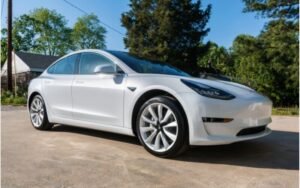How Big is a Tesla Battery? Unveiling the Powerhouse!
Last updated on September 21st, 2023 at 09:37 am
Do you want to know how big a Tesla battery really is? This article answers just that.
Knowing the size of a Tesla battery can help you assess the vehicle’s range and performance metrics better.
A larger battery, in Teslas, means a longer driving range and better acceleration.
It can also give you additional information, such as the battery’s energy costs, environmental impact, and overall efficiency.
Generally, Tesla vehicle batteries range from around 50 to 100 kilowatt-hours (kWh) in capacity, with newer models having larger batteries within 100-120 KWh for extended range and performance.
This article will highlight the various Tesla models’ specific battery sizes, weights, and performance capacities.
Furthermore, you will know how many batteries a Tesla vehicle needs by the end. Let’s delve in.
What Is the Size of a Tesla Battery?

The size of a Tesla battery varies depending on the model of Tesla. Still, they generally fall around the following dimensions:
- Length: 68.5-185.4 cm (27-73 in)
- Width: 29.2-30 cm (11.5-11.8 in)
- Height: 9 cm (3.5 in)
The Tesla Model 3 has the largest battery pack, with dimensions of 185.4 x 29.2 x 9 cm (73 x 11.5 x 3.5 in).
The Tesla Model S and Model X have smaller battery packs, with dimensions of 68.5 x 30 x 75 cm (27 x 11.8 x 29.5 in).
Below is a table containing various Tesla models and their length, width, and height battery dimensions.
| Model | Length (cm) | Width (cm) | Height (cm) |
|---|---|---|---|
| Tesla Model 3 | 185.4 | 29.2 | 9 |
| Tesla Model S | 68.5 | 30 | 75 |
| Tesla Model X | 68.5 | 30 | 150 |
| Tesla Model Y | 187 | 29 | 150 |
| Tesla Cybertruck | 162.9 | 280 | 163.5 |
| Tesla Roadster 2023 | 446 | 193 | 113 |
In addition, each Tesla battery pack comprises thousands of individual cylindrical battery cells.
The cells are 18 mm in diameter and 65 mm in height. The cells are arranged in modules, and the modules are then stacked together to form the battery pack.
Furthermore, the physical dimensions of the Tesla battery pack are vital because they affect the size and weight of the car.
The larger the battery pack, the more energy it can store, but the heavier the vehicle will be.
What Is a Tesla Battery’s Capacity?
A Tesla battery’s capacity depends on the vehicle’s specific model. The battery capacity is the energy a Tesla battery can store and is measured in kilowatt-hours (kWh).
Below is a table that features various Tesla models alongside their trim levels and battery capacities.
#1. Model 3
| Trim Level | Battery Capacity |
|---|---|
| Standard Range Plus | 50 kWh |
| Long Range | 75 kWh |
| Performance | 82 kWh |
#2. Model S
| Trim Level | Battery Capacity |
|---|---|
| Long Range | 100 kWh |
| Plaid | Plaid kWh |
#3. Model Y
| Trim Level | Battery Capacity |
|---|---|
| Long Range | 75 kWh |
| Performance | 82 kWh |
There are several reasons why most Tesla models have separate battery capacities.
A crucial reason is the fact that the battery capacity of an electric vehicle directly affects the driving range.
Larger batteries provide more energy storage and, consequently, longer driving ranges before requiring a recharge.
For example, the 2021 Tesla Model 3 Standard Range Plus has a battery capacity of 54 kWh and a range of 263 miles.
Compared to the Tesla Model 3 Long Range, which has a battery capacity of 82 kWh and a range of 358 miles.
Below are other reasons behind the capacity of a Tesla battery on a specific model.
#4. Performance
For Tesla vehicles to deliver quick acceleration and high speeds, the battery must be capable of delivering higher power outputs.
Therefore, this necessitates a larger battery capacity to store more energy and sustain performance demands.
#5. Vehicle Type and Size
The size and weight of the vehicle will also influence the size of the battery. Larger and heavier vehicles require more energy to move and maintain speed.
Powering these larger vehicles would require larger batteries. The case is the reverse for smaller and lighter cars.
#6. Cost Considerations
Larger-capacity battery packs are generally more expensive to produce.
Tesla aims to balance performance, range, and affordability, influencing the battery capacity and size they select for different vehicle models.
What Is the Weight of a Tesla Battery?
The weight of a Tesla battery depends significantly on the specific model of the vehicle and the battery’s capacity.
Below is a table that highlights various Tesla models and the weight of their battery pack in Ibs and Kg.
| Model | Battery Weight (lbs) | Battery Weight (Kg) |
|---|---|---|
| Tesla Model 3 | 1060 | 480 |
| Tesla Model Y | 1700 | 771 |
| Tesla Model S | 1200 | 544 |
| Tesla Model X | 1183 | 536 |
| Tesla Semi | 10,000 | 4536 |
The table above shows that the Tesla Semi has the heaviest battery, followed by the Tesla Model X, while the Tesla Model 3 has the lightest battery.
Tesla prioritizes several factors regarding the weight of their car batteries. Factors such as the size of the battery, the type of cells used, and the packaging are all integral.
The larger the battery, the more energy it can store and the heavier it will be. The type of cells used also affects the weight of the battery.
Lithium-ion batteries are the most common type of battery used in Tesla cars, and they are lighter than other types of batteries, such as lead-acid batteries.
Furthermore, the packaging of the battery also affects its weight.
Tesla batteries are typically packaged in a cylindrical shape, which is more efficient than other shapes, such as square or rectangular. All these factors influence the weight of a Tesla battery.
In addition, the balance between range and performance defines the weight of a Tesla battery. A heavier battery promises extended range but at the cost of reduced agility.
When designing each model’s battery, Tesla engineers look for a middle ground between these two integral factors.
Moreover, the weight of the battery significantly influences the car’s price, with higher-priced models accommodating larger, heavier batteries.
How Many Batteries Does a Tesla Need?
Teslas do not have individual batteries. What they have, instead, is a large battery pack that contains thousands of small lithium-ion battery cells.
The number of cells in a Tesla battery pack depends on the model of the car.
Here is a table highlighting the number of lithium-ion cells contained in the battery packs of a few Tesla models.
| Model | Number of Lithium-ion Cells |
|---|---|
| Tesla Model S | 7104 |
| Tesla Model 3 | 4680 |
| Tesla Model Y | 4416 |
The battery cells in a Tesla battery pack are arranged in modules.
Each module contains a certain number of cells, and the number of modules in a battery pack also depends on the model of the car.
Below is a table listing the number of modules in a few Tesla models.
| Model | Number of Modules |
|---|---|
| Tesla Model S | 16 |
| Tesla Model 3 | 4 |
| Tesla Model Y | 4 |
For better clarity, the total number of batteries in a Tesla battery pack is the product of the number of cells in each module and the number of modules in the battery pack.
And so for example, the Tesla Model S battery pack has 16 modules, each containing 444 cells, which gives a total of 7,104 batteries (16 modules * 444 cells).
However, the number of batteries in a Tesla battery pack is constantly evolving as Tesla improves its battery technology.
The Tesla Model 3, which originally had a battery pack containing 2,170 and 18650 lithium-ion type cells, was switched to solely 2170 lithium-ion battery cells in the Model 3.
This resulted in an increase in the number of batteries in the battery pack to 4,680 cells.
In addition, the number of batteries in a Tesla battery pack also affects the range of the car.
The Tesla Model S with the 7,104 battery pack has a range of up to 390 miles, while the Tesla Model 3 with the 4,680 battery pack has a range of up to 358 miles.
Moreover, in addition to the large battery pack, Tesla cars have a small 12-volt battery that powers the car’s electrical systems when the main battery is not in use.
This battery is not as large as the main battery and does not affect the range of the electric vehicle.
What is the Capacity of a Tesla Battery?
The tesla battery capacity explained refers to the amount of energy the battery can store. It varies depending on the specific model and configuration. For instance, the Model S Long Range has a capacity of around 100 kWh, while the Model 3 Standard Range has a capacity of about 54 kWh. The battery capacity directly affects the vehicle’s driving range, determining how far it can travel on a single charge.
FAQs
What Kind of Battery Is Used in Tesla Cars?
Tesla cars use lithium-ion batteries due to their high energy density, which enables them to store large amounts of energy in smaller containers.
Which Tesla Has the Longest Range?
The Tesla with the longest range is the Model S Long Range. It has an EPA-estimated range of 405 miles. The Model S Plaid, the fastest Tesla, has a shorter range of 390 miles.
What Is the Lifespan of a Tesla Battery?
Tesla batteries can last for 300,000 to 500,000 miles or 1,500 battery cycles. That is around 22 to 37 years. It is important to note that the Lifespan of the battery depends on several factors.
What Tesla Has the Highest Battery Capacity?
The 2023 Tesla Model S Plaid has the highest battery capacity. Its 100 kWh battery pack gives it an EPA-estimated range of 405 miles (652 km).

Hey, I’m Michael Davis, a 35-year-old with a degree and a love for cars and tech. Since I was a kid, cars have been my thing—so much that I even thought they ran on magic beans! Fast forward, and I’ve built Vehicle Army, your one-stop-shop for easy-to-understand car facts.






